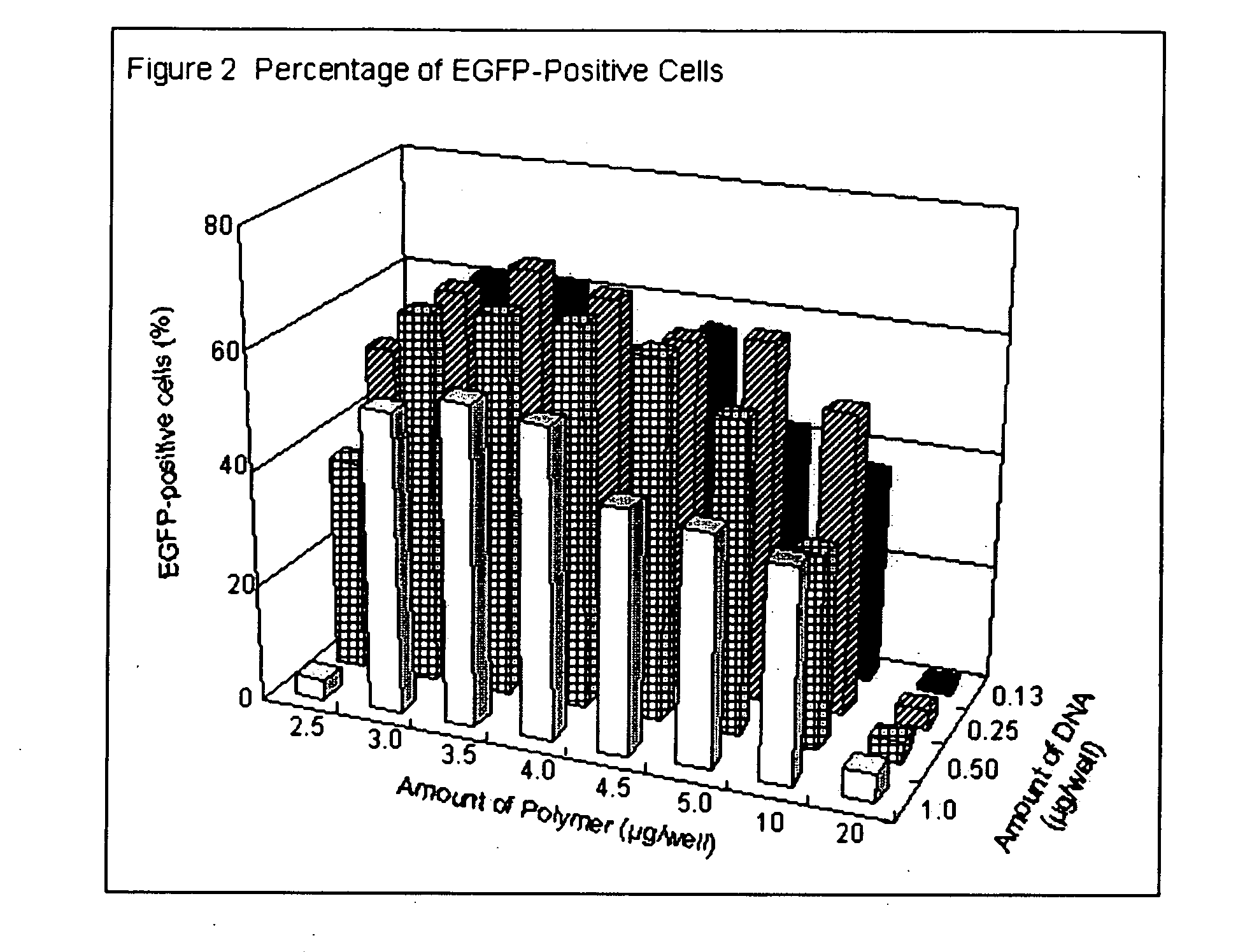Solid surface with immobilized degradable cationic polymer for transfecting eukaryotic cells
a cationic polymer and immobilized technology, applied in the field of solid surface with immobilized degradable cationic polymer for transfecting eukaryotic cells, can solve the problems of limiting the application of viral vectors in vitro, affecting the safety of viral vector preparation, and affecting the applicability of viral vectors, etc., to achieve the effect of avoiding significant loss of transfection activity
- Summary
- Abstract
- Description
- Claims
- Application Information
AI Technical Summary
Benefits of technology
Problems solved by technology
Method used
Image
Examples
example 1
Preparation of Degradable Cationic Polymer
[0098] The synthesis of a polymer which is derived from polyethylenimine oligomer with molecular weight of 600 (PEI-600) and 2,4-pentandiol diacrylate (PDODA) is provided as a general procedure for preparation of a degradable cationic polymer. To a vial, 4.32 g of PEI-600 in 25 ml of methylene chloride were added by using pipette or syringe. 2.09 g of PDODA was quickly added to the above PEI-600 solution with stirring. The reaction mixture was stirred for 4 hours at room temperature (20° C.). Then, the reaction mixture was neutralized by adding 50 ml of 2M HCl. The white precipitate was centrifuged, washed with methylene chloride, and dried at room temperature under reduced pressure.
example 2
Preparation of Transfectable Cell Culture Device with Degradable Cationic Polymer
[0099] Degradable cationic polymer was prepared as indicated in Example 1. Linear polyethyleneimine (L-PEI) based polymer and lipid based polymers were used for transfecting plasmid DNA into mammalian cells in vitro to evaluate the transfection efficiency. For L-PEI based polymer, jet PEI (Qbiogene) transfection reagent was used. Lipofectamine2000 (Invitrogen) and N-[1-(2,3-dioleoyloxy)propyl]-N,N,N-trimethylammonium salts (DOTAP; Sigma-Aldrich) were employed as lipid based polymers. Degradable cationic polymer and DOTAP were dissolved in methanol, and jet PEI and Lipofectamine2000 were diluted by deionized water. Flat bottom 96-well cell culture plates (bottom surface: 0.32 cm2 per each well; BD Biosciences) were treated with these polymer solutions. The actual amounts affixed on the bottom were as follows: (a) Degradable cationic polymer; 3 μg per well, thus 9.4 μg / cm2, (b) jet PEI; 1 μl per well, (c...
example 3
Transfection with Transfectable Cell Culture Device for 293 Cells
[0100] 25 or 50 ng of pEGFP-N1 plasmid (purchased from Clontech) in 25 μl of opti-MEM I (Invitrogen) was added in each well and kept at room temperature for 25 minutes. Then, 5×104 of 293 cells in 100 μl of Dulbecco's modified Eagle Medium (DMEM) (Invitrogen) with 10% calf serum (Invitrogen) were added and incubated at 37° C. in 7.5% of CO2. After 24 to 36 hrs. incubation, transfection efficiency was estimated by observing EGFP fluorescence by using epifluorescent microscope (IX70, Olympus).
[0101] Transfection efficiencies are shown in Table 3. Degradable cationic polymer and jet PEI, i.e. L-PEI based polymer showed high transfection efficiency.
TABLE 3PolymerEGFP-positive cellsDegradable cationic polymer60-70%Jet PEI50%Lipofectamine2000Less than 10%DOTAP 4 pmole / well0%DOTAP 2 pmole / well0%
PUM
| Property | Measurement | Unit |
|---|---|---|
| Time | aaaaa | aaaaa |
| Time | aaaaa | aaaaa |
| Time | aaaaa | aaaaa |
Abstract
Description
Claims
Application Information
 Login to View More
Login to View More - R&D
- Intellectual Property
- Life Sciences
- Materials
- Tech Scout
- Unparalleled Data Quality
- Higher Quality Content
- 60% Fewer Hallucinations
Browse by: Latest US Patents, China's latest patents, Technical Efficacy Thesaurus, Application Domain, Technology Topic, Popular Technical Reports.
© 2025 PatSnap. All rights reserved.Legal|Privacy policy|Modern Slavery Act Transparency Statement|Sitemap|About US| Contact US: help@patsnap.com



